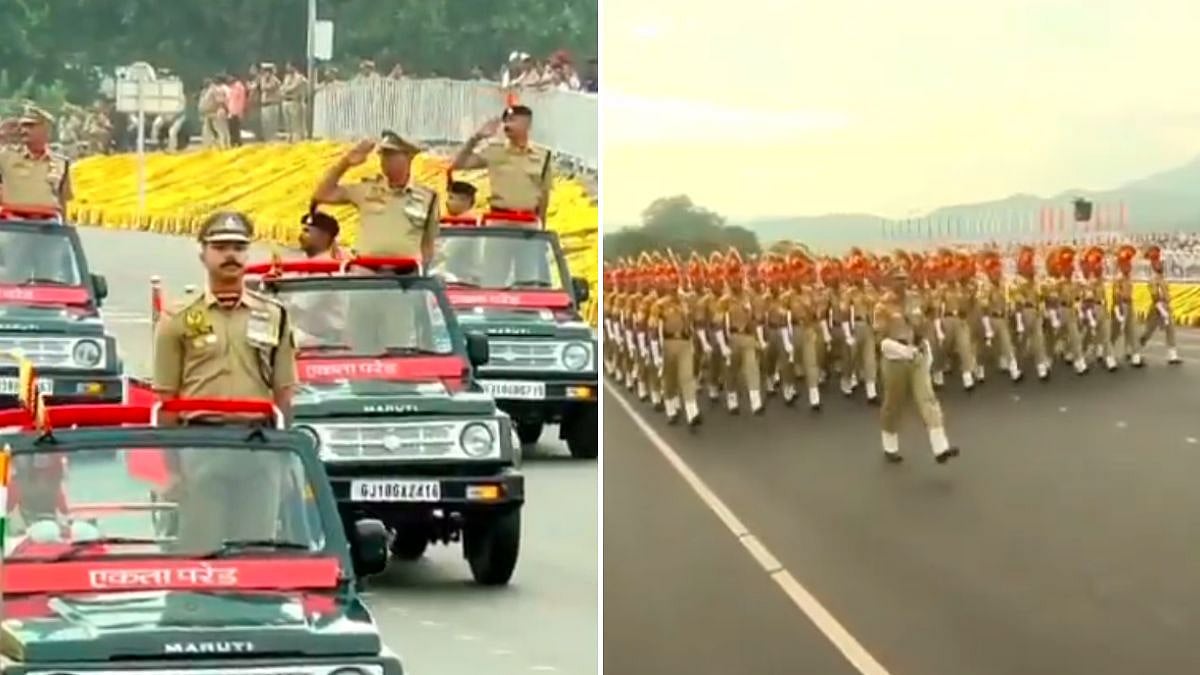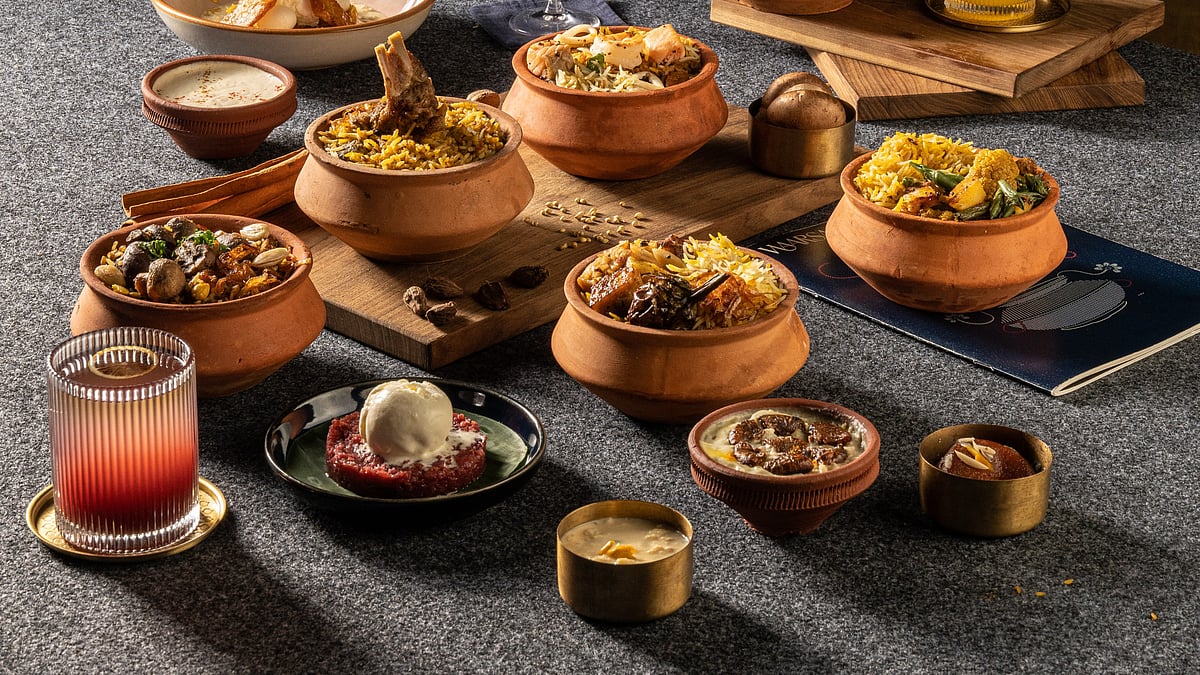From sassy style divas to traditional couture czarinas, all are parading sartorial lines that bear religious and ethnic signs, imageries imported from nature and motifs drawn from ancient civilisations, thus harking back to the times when artisans and craftsmen were revered for their painstaking handicrafts, reflecting the rich cultural heritage of a region. This trending arty fashion is called ajrakh.
Fusion funda
Conversing about re-exploring ajrakh on the runways nowadays, one wonders if it is being given a fusionistic spin. “Absolutely! Ajrakh is at the moment walking an unfamiliar route through innovation and experimentation. It is now in its 2.0 phase. We see it in chic silhouettes, out-of-the-box cuts and unexpected pairings that mix the erstwhile aesthetics with upgraded concepts,” pat comes designer Shivani Sohal’s shot on ajrakh’s redefined avatar. She is the creative force behind Rooh by Shivani.
“In today’s fashion world, ajrakh is being lent a new identity. Designers are incorporating ajrakh prints into contemporary silhouettes, blending traditional techniques with leading-edge cuts to create a distinctive and versatile style,” avers fashion designer Anushka Khanna.
Ajrakh is being prominently re-invented in Gen-Z's fashion realm by coalescing different styles. “Designers are seamlessly merging old-styled ajrakh aesthetics with modern elements, creating enticing trends that smoothly gel with contemporary fashion norms,” observes eminent costume designer and fashion couturier Neeta Lulla, while elaborating on the huge rage of jumping on the ajrakh bandwagon.
Exploring ajrakh in present-day fashion circles, especially among the swish set, is like finding a hidden gem and giving it an updated twist. “Drapers are clubbing ajrakh patterns with novel, avant-garde styles, delineating a fusion that not only preserves its legacy but also makes it effortlessly comfy, hip and happening for the youth,” concedes Gautam Gupta, co-owner of the label Asha Gautam.
Spectacular spectrum

Usually, red, blue, black, green and yellow are used in ajrakh as its main colours. However, new-age designers prefer pouring more shades onto the palette, as they love to toy with something extra and different.
“While traditional ajrakh features red, blue, black and green, modern designers might experiment with a diverse palette. Mauve, teal and mustard inject fresh vibrancy into ajrakh creations,” chimes in Sohal.
Khanna insists to dabble in additional hues like earthy tones, muted pastels and deep jewel tints to expand the palette. The traditional shade card is indeed iconic but farsighted designers could explore softer pastels and earthy dyes to widen the ajrakh colour spectrum. Dusty pinks, subdued lavender and subtle grays can complement the more oft-used hues, offering a multidimensional angle to various fashion expressions,” renders Sohal.
The colour wheel can be extended from soothing pastels to earthy tones. “There's so much potential for emerging designers to play with a splash of shades that would integrate today's plethora of fashion styles and allow more room for creativity with a broader range of ideas to proliferate on the chosen material,” assures Gupta.
Arduous ajrakh
An ajrakh fabric goes through a series of washing, traditional leheriya style of tying and dyeing, resist printing and sun-drying process. It dates back to the eons-old routine of upholding the treasure-trove of national cultural heritage. One doubts if the rigorous grind of this art will survive the machine-driven modern age where everything is done at the drop of a hat and things are believed to be achieved immediately.
“The painstaking process behind crafting ajrakh with its tie-and-dye techniques, resist printing and sun drying reverberates a time period when artisans were held in high esteem and paid their due respect,” stresses Gupta. “In this jet age, it's a challenge to maintain this degree of perseverance but the wholehearted regard for this handcrafted art and the cultural heritage that it represents might just be the key to keeping its legacy alive. It depends on continued support for the fading and dying craftsmanship and sustainable practices to retain such unique artforms,” he argues ahead.
Lulla believes that the authenticity of ajrakh will thrive steadily. “The traditional techniques and laborious methods stand as a testament to its cultural heritage, ensuring its resilience on the ever-evolving fashion landscape,” she lays an emphasis.
“The very process of fashioning an ajrakh creation contains the hallmark of its authenticity,” declares Sohal. “As designers, we must champion these traditional modes and techniques, fostering an understanding and awareness of the craftsmanship and dedication that go into carefully creating each piece,” she infers.
The hectic process of creating ajrakh mirrors a commitment to traditional craftsmanship. “Despite the obstacles posed by the electronic age, there is a rising admiration for handmade, indigenous art and crafts noticed all over. This, in turn, insinuates at the endurance power of the art,” Khanna buoys hope.
Accompanying in ajrakh
Accessories like jholas, potlis, scarves, pagdis or even footwear, etc. are obtainable in ajrakh. These provide an opportunity to implant this distinguishing style into various elements of one's ensemble. Ajrakh accessories are diverse in range. Its gamut unveils a hint of heritage in contemporary fashion, enabling individuals to embrace ajrakh in different aspects of their wardrobe.
Ajrakh spells out its charm in varied accessories like bags, stoles, jewellery, stationary items, diary covers, et al, adding a dash of elegance to every feature of fashion.
Designs on men
If female style goddesses ride in the driver’s seat when it comes to flaunting ajrakh fashion, the male bastion too is not oblivious to this fad. For men’s outfits are also generously accessible in ajrakh.
A gentleman’s options in ajrakh encompass kurtas, bandhgalas and jackets, underpinning the finesse of this traditional art form in crafting sophisticated and stylish menswear.
Gupta feels that men's ethnic wear gets a timeless transformation with ajrakh, offering kurtas, shirts, jackets, turbans and much more. “The traditional themes and earthy pigments make it a favourite pick for those seeking bonafide, cerebral, understated and cultural fashion,” he affirms.
Vintage vantage
Traces of ajrakh were found in the excavated remains of the Indus Valley Civilisation. For instance, the bust of a priest king. Can that old world charm appeal to today’s fashionistas and designers?
“Ajrakh's connection to the Indus Valley civilization is like discovering a hidden wealth of history in your wardrobe. The rich dug-up remnants of yesteryears have a timeless enigma, surprisingly capturing the imagination of today's hipsters,” opines Gupta.
Seconding him, Sohal adds that “although ajrakh appears to be caught in a time warp, it serves as a vital bridge between the past and the present, offering a sense of nostalgia and cultural connection.”
“The antique attraction of ajrakh with its roots embedded in the timeframe of Harappan and Mohenjo-daro cultures impress designers and wearers alike, forging a bond between heritage and timeless style,” reports Khanna.
Organic oeuvre
Vegetable dyes were earlier used to craft out ajrakh. In sync with that, several organic methods can be applied today to retain ajrakh’s sustainability.
“Espousing sustainability, contemporary artisans can use natural colours to preserve ajrakh's eco-friendly essence, thus aligning with the prevalent preferences for conscious and ethical fashion and fashion for development,” suggests Lulla.
To retain ajrakh’s sustainability, “designers may adopt natural dyes, eco-friendly fabrics and water-conserving practices in the production process,” Khanna dispenses tips.
“Designers could explore organic dyeing methods using plant-based and earthy tinges. This not only adapts to eco-friendly practices but also lifts the craft's charisma to environmentally-conscious consumers,” claims Sohal.
Gupta envisages that “eco-friendly printing processes with sustainable outsourcing of materials could elevate ajrakh’s magnetic power.”
Mix and match
Ajrakh can certainly be paired with western wear in a mix-and-match fashion. For example, an ajrakh-printed scarf or a jacket can be teamed with jeans and a solid-coloured top to create a fusion of traditional and contemporary styles. Ajrakh blazers can be worn with solid-coloured or striped sarees. Ajrakh pants can be sported with high-neck solid tops and heavy accessories.
Incorporating ajrakh prints into contemporary silhouettes like shirts, skirts or dresses creates a unique fusion of traditional and unorthodox styles.
“Ajrakh can be amalgamated with western coordinates like jackets, shirts, corsets, bomber jackets or even long dresses offering a unique fashion statement of intermingling disparate styles that transcends cultural boundaries and celebrates global fusion flair,” holds Lulla.
A printed ajrakh jacket over jeans or an ajrakh maxi dress with contemporary accessories unfurls a unique fusion look.
Futuristic feel
Boho chicks and maverick artists/musicians love wearing this kind of past-meets-present outfits. Without distorting its authenticity, has ajrakh emerged as a fashion-forward diktat?
“To emerge as a futuristic trend, ajrakh creators and custodians could collaborate with contemporary designers, participate in fashion events and explore innovative applications, thereby maintaining its authenticity and appealing to a broader audience simultaneously. It could be a cross between the old school of thought and revolutionary tenets,” advises Khanna.
Lulla comments that “one may incorporate ajrakh in asymmetrical silhouettes, block cuts or bias structures for prêt-à-porter (ready-to-wear) fashion or to cater to the affordable-yet-niche bridge-to-luxury market, creating an individual style statement within the framework of its timeless artistic magic.”
“To arrive as a fashion of tomorrow in today’s times, the conventional ajrakh community may coordinate with progressive designers on shaping avant-garde pieces that resonate authenticity while pushing creative limits. Experimenting with unconventional apparel designs, innovative color mishmashes and unique applications can help ajrakh stay relevant in the always mutable fashion arena,” muses Gupta.
Maintaining ajrakh's genuineness and validity while appealing to a fashion-forward audience with panache necessitates tapping new terrains like age-defying cuts, silhouettes and styling techniques. “It's about finding a balance that rightly respects traditional aesthetics as well as endorses the fluctuating tastes and sensibilities of modern-day stylistas,” signs off Sohal.














